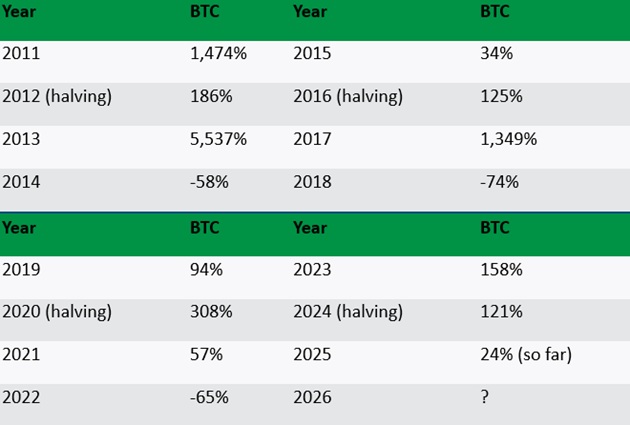"3 up, 1 down." This represents the historical rhythm that Bitcoin (BTC) and cryptocurrency values have typically followed.
We refer to it as the four-year cycle. It was a sequence so reliable, you could synchronize your timepiece to it, as demonstrated by this chart of Bitcoin's yearly performance:

Numerous investors continue to operate according to this four-year framework. However, as I'll demonstrate, the conventional four-year pattern has likely concluded, and that's actually positive news.
January 11, 2024 . . .
The moment Bitcoin's rhythm broke.
What occurred that day?
The initial Bitcoin ETFs commenced trading in the United States.
Bitcoin was previously a fringe asset. To acquire it, you needed to establish a cryptocurrency wallet, transfer your funds to a suspicious-looking exchange, and hope it remained secure. And incorporating it into your retirement portfolio was virtually impossible. Too complicated for most people.
Currently, you can purchase Bitcoin as straightforwardly as Apple Inc. (AAPL:NASDAQ) or Tesla Inc. (TSLA:NASDAQ).
ETFs unlocked access to Wall Street capital. And funds rapidly streamed in. BlackRock, Inc.'s (BLK:NYSE) Bitcoin ETF — the iShares Bitcoin Trust ETF (IBIT) — emerged as the fastest-expanding ETF ever. Within less than two years, $87 billion flowed into it. It represents the most successful ETF introduction in history, by a substantial margin. For context, the biggest gold ETF — the SPDR Gold Trust (GLD) — has existed for over twenty years and manages $100 billion. I anticipate IBIT will exceed GLD within the coming months.
Hello, infinite bid. . .
The reality that anyone can easily purchase BTC and Ethereum (ETH) through an ETF has fundamentally altered cryptocurrency markets permanently.
The "infinite bid" from wealth administrators constitutes the most significant positive force in cryptocurrency's existence.
Cryptocurrency is now substantially controlled by professional investors who are theoretically less susceptible to excessive speculation. Though I'll share a secret: Many I'm familiar with remain impulsive gamblers.
This suggests the explosive peaks and devastating 80% collapses we've become accustomed to will likely transform into more consistent upward trends interrupted by less severe corrections.
The traditional four-year cycle has likely concluded, and that's actually positive news. Less frenzied expansion. More sustainable growth. This shift mirrors financial market evolution. Early stock markets experienced complete panics every couple of years, while contemporary markets face crises every 20–30 years.
Cryptocurrency is following the same maturation trajectory, just compressed into a briefer timeframe.
This consistent influx of capital didn't exist in cryptocurrency . . . at least until ETFs arrived.
When tens of millions of Americans receive paychecks biweekly, they invest in stocks through their retirement accounts and 401(k)s. This generates ongoing demand for stocks, which I'd suggest establishes a minimum price threshold.
Now, the planet's largest asset managers — including BlackRock, Fidelity, VanEck, and others — are advising their clients to acquire and maintain BTC in their 401(k)s.
The barriers have collapsed. Billions of dollars of Wall Street capital are entering cryptocurrency for the first time ever. There's $8 trillion allocated in 401(k) plans currently. If cryptocurrency captures merely 1% of 401(k) assets, that's $80 billion in fresh money entering the market.
If you're curious about our position in the Bitcoin cycle, you're focusing on the wrong issue.
The more relevant question is: Which cryptocurrency asset will Wall Street target next?
Bitcoin was the first "legitimate" cryptocurrency that institutions could engage with. Everything else was too ambiguous. The regulatory uncertainty was excessive.
But that's changing as well.
The current U.S. administration has made its stance clear. They intend to "make America the crypto capital of the world" (their words).
In recent weeks, Congress approved several pro-cryptocurrency bills that will provide the industry with essential regulatory clarity. Regulation has shifted from risk to opportunity. And now, the entire cryptocurrency space will become accessible to Wall Street. That's driving investment currently.
Ethereum stands as the obvious successor.
It offers considerably more functionality than Bitcoin. It's rapidly becoming the settlement foundation for a new global financial infrastructure.
Robinhood Markets Inc. (HOOD:NASDAQ) is developing its tokenized stock platform on Ethereum. A selection of companies creating products on Ethereum includes: PayPal Holdings Inc. (PYPL:NASDAQ), Visa Inc. (V:NYSE), Stripe, Fidelity,JPMorgan Chase & Co (JPM:NYSE), Mastercard Inc. (MA:NYSE), and Shopify Inc. (SHOP:NASDAQ).
Wall Street is finally recognizing this potential.
Inflows into ETH ETFs are accelerating exponentially.
From July 2024 to June 2025, a total of $4.2 billion entered these funds. This month alone (July 2025), witnessed $4.4 billion pour into the ETH ETFs! That indicates Wall Street is moving into cryptocurrency in a big way.
One final thing: the Bitcoin cycle may be dead, but the opportunity in crypto is very much alive. I’ll have more to say on emerging crypto developments in future issues of my twice-weekly investing letter The Jolt. If you’d like to join, you can sign up here.
| Want to be the first to know about interesting Cryptocurrency / Blockchain investment ideas? Sign up to receive the FREE Streetwise Reports' newsletter. | Subscribe |
Important Disclosures:
- Stephen McBride: I, or members of my immediate household or family, own: Ethereum. My company has a financial relationship with: None. My company has purchased stocks mentioned in this article for my management clients: None. I determined which companies would be included in this article based on my research and understanding of the sector.
- Statements and opinions expressed are the opinions of the author and not of Streetwise Reports, Street Smart, or their officers. The author is wholly responsible for the accuracy of the statements. Streetwise Reports was not paid by the author to publish or syndicate this article. Streetwise Reports requires contributing authors to disclose any shareholdings in, or economic relationships with, companies that they write about. Any disclosures from the author can be found below. Streetwise Reports relies upon the authors to accurately provide this information and Streetwise Reports has no means of verifying its accuracy.
- This article does not constitute investment advice and is not a solicitation for any investment. Streetwise Reports does not render general or specific investment advice and the information on Streetwise Reports should not be considered a recommendation to buy or sell any security. Each reader is encouraged to consult with his or her personal financial adviser and perform their own comprehensive investment research. By opening this page, each reader accepts and agrees to Streetwise Reports' terms of use and full legal disclaimer. Streetwise Reports does not endorse or recommend the business, products, services or securities of any company.
For additional disclosures, please click here.









































